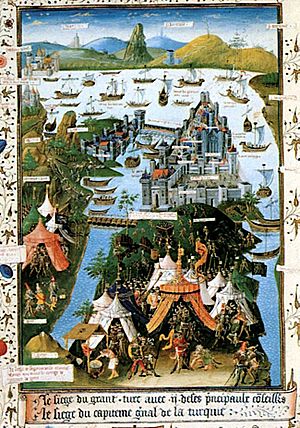Imperial Library of Constantinople facts for kids
The Imperial Library of Constantinople was one of the most important libraries in the world. Located in Constantinople (modern-day Istanbul, Turkey), the capital of the Byzantine Empire, it was the last of the great libraries of the ancient world.
For almost 1,000 years, this library protected the knowledge of the ancient Greeks and Romans. It saved many books long after other great libraries, like the Library of Alexandria, were gone.
Over the centuries, fires and wars damaged the library. The Fourth Crusade in 1204 was especially destructive. Although many stories say some books survived, no large part of the library has ever been found.
The library was started by Emperor Constantius II around 350 AD. He created a special room called a scriptorium, where people copied old Greek books onto new materials to make them last longer. Most of the ancient Greek classic stories we know today exist because of the copies made in this library.
Contents
Creating the Great Library
In ancient times, most books were written on papyrus, a material made from a plant. But papyrus would rot and fall apart over time. To save the knowledge on these scrolls, people began copying them onto parchment, which is made from animal skin and is much stronger.
Emperor Constantine the Great started this project for religious books. His son, Constantius II, expanded it to include all kinds of Greek literature. He hired a team of calligraphers (people with expert handwriting) and librarians, led by a scholar named Themistius. Their goal was to copy as many ancient texts as possible. It is believed the library grew to hold over 100,000 books and scrolls.
What Was Inside the Library?
The team at the library had to choose which books were most important to save. They focused on very old and famous works.
Important Books and Authors
The stories of Homer, like The Iliad and The Odyssey, were a top priority. One famous scroll of Homer's work was said to be 120 feet long and written with ink made of gold! They also saved many plays and histories from the golden age of Greece.
Writers like Sophocles and others who wrote about grammar and language were also chosen. Because the librarians had to be selective, some books they knew about are now lost forever. We only know they existed because scholars like Themistius wrote about them.
A Spanish visitor named Pero Tafur came to Constantinople in 1437. He wrote that the library was filled with ancient books and histories. He described it as a simple place with strong, plain furniture.
The Mystery of the Library's Disappearance
So what happened to all these amazing books? The library's collection slowly vanished over hundreds of years.
Fires and a Great Siege
Several fires in Constantinople destroyed parts of the library. A huge fire in the year 473 AD burned about 120,000 books. Even so, many books were saved or had already been copied and sent to other places.
A major blow came in 1204 during the Fourth Crusade. Knights from Western Europe attacked and captured Constantinople. During the attack, the city was burned three times. Many historians believe the library was destroyed during this event, and its books were lost or scattered.
Searching for Lost Books
Even after the city was conquered by the Ottoman Empire in 1453, stories continued about a secret collection of books hidden in the Sultan's palace. In 1800, a scholar named Joseph Dacre Carlyle was allowed to search the palace, but he found nothing from the old Imperial Library.
However, sometimes a lost book reappears. The famous Archimedes Palimpsest, a book by the ancient Greek mathematician Archimedes, was discovered in 1840. It had been hidden underneath a prayer book. This gives people hope that other lost texts might still be out there.
Was It Just One Giant Library?
Some historians wonder if there was ever a single, huge building for the Imperial Library, like in Alexandria. After the 5th century, there is not much evidence of one central public library in Constantinople.
Instead, it is likely that there were many libraries. These were often located in churches, monasteries, and the private homes of wealthy nobles. While the Byzantine Empire had many educated people, most libraries were private. These smaller collections, all together, may have formed the great "library" of Constantinople that preserved so much knowledge for the world.
See also
- Magnaura
- Destruction of libraries
- Monastery of Stoudios
- University of Constantinople
- Załuski Library - the oldest modern public library


